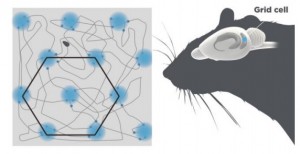May 28 2015
How the Brain Chooses Where to Go
 Neuroscientists are making progress mapping out the cortical pathways that allow us to know where we are and navigate to a desired location. A recent study adds another bit of information to this growing picture.
Neuroscientists are making progress mapping out the cortical pathways that allow us to know where we are and navigate to a desired location. A recent study adds another bit of information to this growing picture.
The Nobel Prize for Physiology or Medicine for 2014 was given to several scientists, Dr. John M. O’Keefe, Dr. May-Britt Moser and Dr. Edvard I. Moser, for their collective research in working out the basic neurological function that underlies our ability to place ourselves in our environment and to navigate around. O’Keefe identified place cells. A specific place cell will fire when we are in a specific location. Different patterns of place cells firing represent different locations.
These place cells are found in the hippocampus, specifically area CA1. O’Keefe also found that the place cells have memory function, and are therefore critical to our ability to remember specific locations.
Moser and Moser extended this work by finding grid cells in the entorhinal cortex. This area connects heavily with CA1, and contains cells that behave like the place cells. However, the grid cells are arranged in a hexagonal grid, and they fire in sequence as rats move through their environments. The grid cells therefore seem to be a literal map of the environment, and track our movement through the environment, while the place cells tell us where we are.
The new study adds yet another piece to this circuit. Hiroshi Ito and others, including Moser and Moser who discovered grid cells, did further studies looking at rat brains as they navigate their environment. In this case they were specifically interested in how the rats decide which direction to go in when confronted with a T in a maze. They used a maze designed like a figure 8 so that as the rats went around they would endlessly come to right-left branchings.
They found a number of things. First, the intensity of firing in the CA1 area predicted in which direction the rat would go. The neurons were all firing, but would fire more intensely in one pattern when the rat went right, and in another pattern when the rat went left.
They also identified a circuit leading from the prefrontal cortex to the nucleus reuniens in the thalamus and then to the CA1 area of the hippocampus. The prefrontal cortex is essentially part of the decision-making part of the brain. The thalamus is the main relay center in the brain. This circuit, therefore, makes sense based upon our current models of brain circuitry.
The researchers found that the differential firing of the CA1 neurons predicting navigation direction stopped when they lesioned or blocked signals from either the prefrontal cortex or the nucleus reuniens.
This circuit, from prefrontal cortex to nucleus reuniens, and then to the place cells in CA1, which itself connects to the grid cells in the entorhinal cortex nearby, allows us to think about where we are, where we want to go, and how to get there. This may not be the complete circuit, but it seems like the core portion of it at least.
These types of circuits in the brain likely represent the low-hanging-fruit for neuroscientists because they display some version of what is called somatotopic organization. In other word, the layout of the neurons reflect their function. In this case, grid cells are literally laid out in a grid that reflects the outside world. Another part of the brain that reflects a physical lay out that relates to external reality is the visual cortex. Neurons light up in a pattern that reflects the actual image that is being viewed.
These core physical functions are a great opportunity for scientists to explore the circuitry of the brain. However, there are many other circuits in the brain that subsume more abstract functions that will likely prove more challenging to map out. Imagine the complexity of the circuitry that represents language, for example.
Another advantage of basic functions like navigation is that we can study rats. We can’t study rats to map out the circuitry of language, however.
We might not even have the tools yet to explore brain circuitry in sufficient real-time resolution to map out the more complex and abstract functions. Technological advancements here, however, are making steady progress, and so our ability to map out brain circuits will likely continue to improve with the technology. I also think that efforts to reproduce brain function in computers will greatly advance our efforts to map the brain’s circuits (and vice versa).
It is always difficult to predict how long a certain scientific endeavor will take. It tends to be slower at first than we hope or imagine, but then quickly becomes faster than anyone expected as technology advances. Think of the human genome project, which accelerated by orders of magnitude over the length of the project. We are now engaged in the human connectome project. As new tools come online the pace of progress will increase. It’s hard to say if progress will be as dramatic as it was with the genome project, but it might be.






